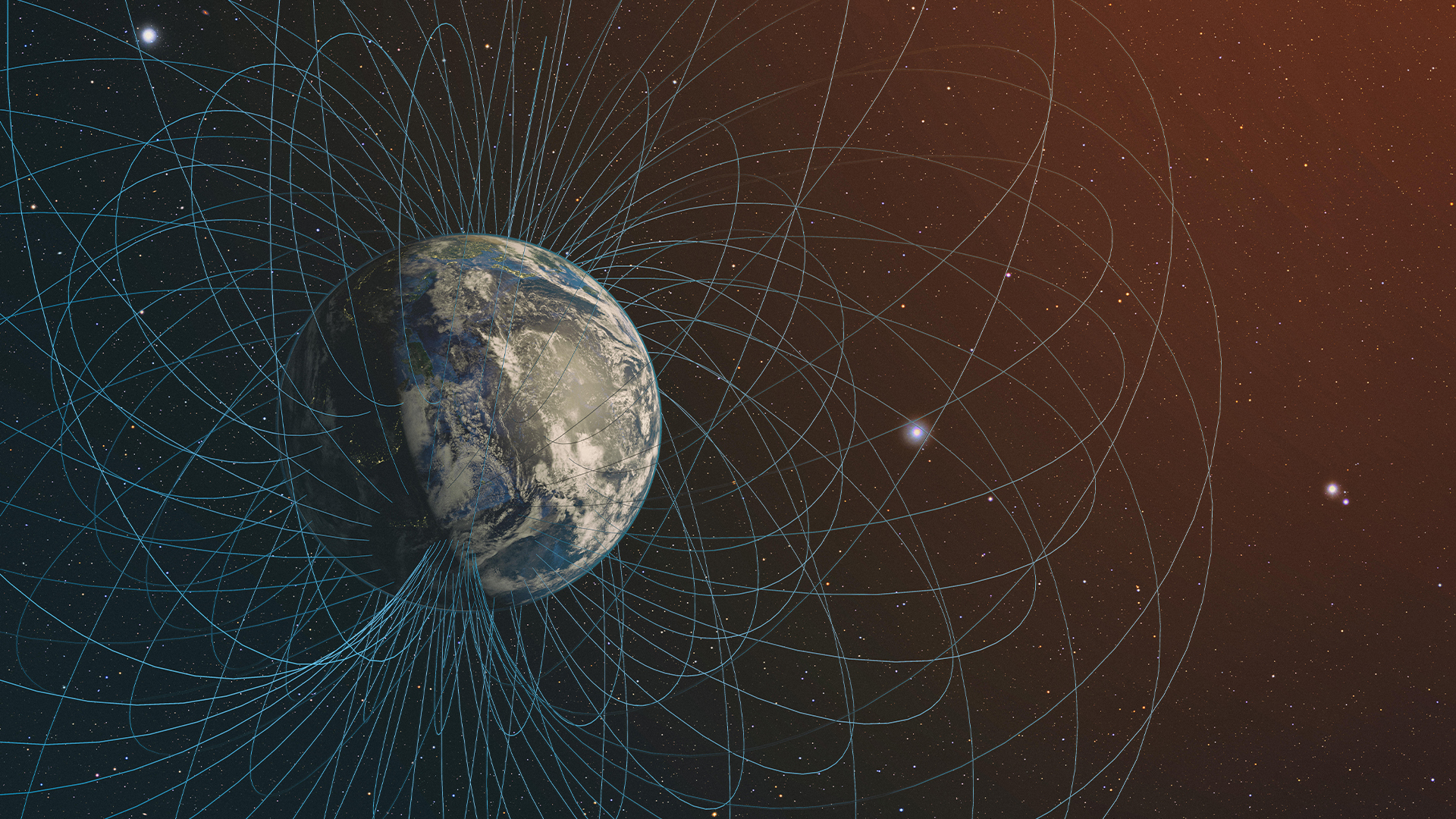Why does Earth have magnetic poles?
Earth is the only rocky body in the inner solar system with strong magnetic poles. But where do these poles come from, and what do they do?

Earth is unique in the solar system for a number of reasons: It's the only planet with a breathable oxygen atmosphere, it's covered in liquid water and it's the only celestial body (that we know of) to harbor life. An often-overlooked characteristic that makes our planet special, however, is that it's the only rocky body in the inner solar system with strong magnetic poles — your compass would be useless on Mars.
But where do these poles come from, and what do they do? To answer these questions, let's start with a journey to the center of our planet.
Earth's core is separated into two layers: the solid inner core and the molten metal outer core. Both layers are made of a cocktail of magnetic iron and nickel, with a few dashes of lighter elements, such as oxygen, silicon and sulfur.
The inner core is extremely dense and hot, like a giant incandescent marble. But the outer core is fluid, and it swirls around this solid mass with its own convective current. It's this constant convection that generates Earth's magnetic field, John Tarduno, a geophysicist at the University of Rochester in New York, told Live Science.
Related: What if Earth's magnetic field disappeared?
As heat from the inner core continuously radiates into the outer core, it meets material cooled by plate tectonic activity. This cycle drives convection, giving rise to the so-called geodynamo that produces the magnetic field.
Other planets, like Mars and Venus, don't have magnetic fields, in part because they lack plate tectonics. Evidence suggests that these planets may have once had self-sustaining geodynamos but that they petered out for unknown reasons. Mercury does have a weak magnetic field, but it is only 1.1% as strong as Earth's and doesn't do much to shield the planet from solar radiation.
Get the world’s most fascinating discoveries delivered straight to your inbox.
As the liquid metal in Earth's outer core flows, its motion and high iron content cause the planet to act like a huge dipolar magnet, with one negatively charged pole and one positively charged pole. Around 80% of Earth's magnetic field is organized this way, but the remaining 20% is non-dipolar; rather than forming parallel bands of magnetic force, there are certain regions where the field swirls and eddies, behaving "like weather patterns that kind of float around," Tarduno said.
These irregular patterns produce weird patches in the magnetic field — places like the South Atlantic Anomaly, a large swath of the Atlantic Ocean where the intensity of Earth's magnetosphere dips dramatically. Researchers think this "dent" in the magnetic field arises from unusual tectonic activity underneath Africa. Areas like the South Atlantic Anomaly are fascinating, but they are also concerning, for a couple of reasons.
"The magnetosphere is like a protective envelope," Joshua Feinberg, a geologist who specializes in paleomagnetism at the University of Minnesota, told Live Science. It helps to deflect huge amounts of dangerous solar radiation away from Earth, acting like a planetwide layer of sunscreen. In areas where the magnetosphere is weak, extra doses of radiation leak through, potentially contributing to higher rates of skin cancer.
"Another concern is the effect on satellites," Tarduno said. Bursts of radiation from the sun called coronal mass ejections can knock out satellites and other spacecraft if they aren't shielded by Earth's magnetic field. This can have catastrophic effects for telecommunications, internet access and GPS services in anomaly-impacted areas.
The South Atlantic Anomaly may be 11 million years old, according to a 2020 paper published in the journal PNAS, and it might be connected to another planetary magnetic-field phenomenon: pole reversal.
The history of Earth's magnetic field is written in ancient lava flows and deep-sea sediments. These types of rocky material are rich in magnetic metal fragments, such as tiny chips of iron, which orient themselves along magnetic-field lines. "Eventually, that original alignment gets locked into the sediments, and we get these deep-time records of how the Earth's magnetic field was oriented," Feinberg said.
From these records, scientists know that our planet's magnetic poles drift over time. Currently, the geographic North Pole is about 310 miles (500 kilometers) away from its corresponding magnetic pole (which is technically magnetic south, at the moment). And roughly every 300,000 years, the poles suddenly flip, reversing magnetic north and south, according to NASA.
However, the paleogeomagnetic record shows that a complete pole reversal hasn't happened in about 780,000 years. Some researchers believe this means that we're due for a flip — and that the strength of the South Atlantic Anomaly could indicate that one is close.
If the poles were to reverse, Earth's magnetic field would dip to 20% strength, possibly for centuries. Such an event would plunge our current global communications system into disarray. However, other studies suggest that a flip is not imminent.
Either way, Feinberg said, studying our planet's interior and the paleogeomagnetic record will help us understand the complex interplay between the magnetosphere and life on Earth — and possibly help us prepare for future change.

Joanna Thompson is a science journalist and runner based in New York. She holds a B.S. in Zoology and a B.A. in Creative Writing from North Carolina State University, as well as a Master's in Science Journalism from NYU's Science, Health and Environmental Reporting Program. Find more of her work in Scientific American, The Daily Beast, Atlas Obscura or Audubon Magazine.



